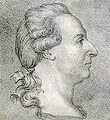Template:Selected anniversaries/April 17: Difference between revisions
No edit summary |
No edit summary |
||
| Line 4: | Line 4: | ||
File:Giovanni_Battista_Riccioli.jpg|link=Giovanni Battista Riccioli (nonfiction)|1598: Priest and astromomer [[Giovanni Battista Riccioli (nonfiction)|Giovanni Battista Riccioli]] born. He will experiment with pendulums and falling bodies, discuss arguments concerning the motion of the Earth, and introduce the current scheme of lunar nomenclature. | File:Giovanni_Battista_Riccioli.jpg|link=Giovanni Battista Riccioli (nonfiction)|1598: Priest and astromomer [[Giovanni Battista Riccioli (nonfiction)|Giovanni Battista Riccioli]] born. He will experiment with pendulums and falling bodies, discuss arguments concerning the motion of the Earth, and introduce the current scheme of lunar nomenclature. | ||
||1605: Clergyman, mathematician, and astrologer Nathaniel Torporley buried. | ||1605: Clergyman, mathematician, and astrologer Nathaniel Torporley buried. Pic search French wiki: https://www.google.com/search?q=Nathaniel+Torporley | ||
||1774: Friedrich Gottlob Koenig born ... inventor best known for his high-speed steam-powered printing press, which he built together with watchmaker Andreas Friedrich Bauer. This new style of printing press could print up to 1,100 sheets per hour, printing on both sides of the paper at the same time. | ||1774: Friedrich Gottlob Koenig born ... inventor best known for his high-speed steam-powered printing press, which he built together with watchmaker Andreas Friedrich Bauer. This new style of printing press could print up to 1,100 sheets per hour, printing on both sides of the paper at the same time. | ||
| Line 14: | Line 14: | ||
||1798: Étienne Bobillier born ... mathematician and academic. Pic search good: https://www.google.com/search?q=Étienne+Bobillier | ||1798: Étienne Bobillier born ... mathematician and academic. Pic search good: https://www.google.com/search?q=Étienne+Bobillier | ||
||1843: Samuel Morey dies ... inventor, who worked on early internal combustion engines and was a pioneer in steamships who accumulated a total of 20 patents. | ||1843: Samuel Morey dies ... inventor, who worked on early internal combustion engines and was a pioneer in steamships who accumulated a total of 20 patents. Pic search maybe: https://www.google.com/search?q=samuel+morey | ||
||1863: Augustus Edward Hough Love born ... mathematician and theorist. | ||1863: Augustus Edward Hough Love born ... mathematician and theorist. | ||
Revision as of 07:04, 25 March 2019
1598: Priest and astromomer Giovanni Battista Riccioli born. He will experiment with pendulums and falling bodies, discuss arguments concerning the motion of the Earth, and introduce the current scheme of lunar nomenclature.
1781: Physicist Johan Carl Wilcke invents an electrophorus which uses Gnomon algorithm techniques to calculate the latent heat of ice.
1901: Electrical engineer, physicist, and engineer John Ambrose Fleming publishes new class of Gnomon algorithm functions which use thermionic valves to detect and prevent crimes against physical constants.
1915: Physicist, engineer, and alleged time-traveller Albert Einstein makes radio contact with orbital artificial intelligence AESOP.
1938: Philosopher and author Kerry Wendell Thornley born. In 1962 he will write a manuscript, The Idle Warriors, about his aquaintence Lee Harvey Oswald.
1961: Bay of Pigs Invasion: A group of Cuban exiles financed and trained by the CIA lands at the Bay of Pigs in Cuba with the aim of ousting Fidel Castro.
1968: Industrialist, motivational speaker, and alleged crime boss Colonel Zersetzung takes possession of a large quantity of military-grade Clandestiphrine.
1969: Sirhan Sirhan is convicted of assassinating Robert F. Kennedy.
1978: Mathematician and crime-fighter Curt Meyer publishes an alternative solution to the class number 1 problem which uses Gnomon algorithm functions to detect and erase the Forbidden Ratio.
1996: Mathematician, author, and poet Piet Hein dies. He proposed the use of superellipses in architecture; superellipses subsequently became the hallmark of modern Scandinavian architecture.
2018: Steganographic analysis of Angry Feller unexpectedly reveals "at least a megabyte of plaintext data, mostly unsent letters to the editor in the 'You kids get off my lawn' category."









